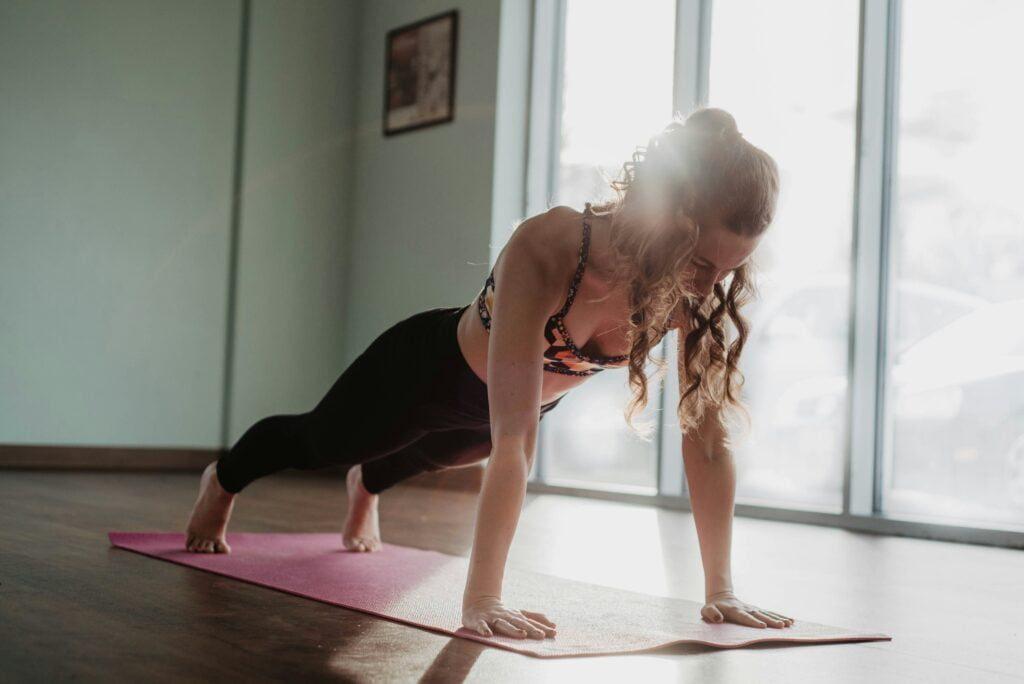Have you ever wondered if that simple-looking core workout could actually transform your fitness regime? Planks, an often underrated element of strength training, pack a powerful punch when it comes to isometric exercise benefits. Not just any plank exercise, but the one done with precision, can unlock a symphony of muscle engagement and core activation that might just surprise you. So we will answer the age old question of do Planks work?
While you’re holding that position, fighting the tick of the clock, know that your body is orchestrating a complex performance of fitness. Each second you sustain the plank, your body assembles a range of muscles into action, from the fortress of your core to the stabilizers in your shoulders. The key is to finesse your form for maximal payoff and minimal risk, ensuring your plank becomes a staple in your personal catalog of functional exercises.
Key Takeaways
- A regular plank exercise is a robust core workout for all fitness levels.
- Isometric exercise benefits go beyond muscle building; they promote endurance and stability.
- Muscle engagement during a plank involves not just the abs, but shoulders, arms, and glutes too.
- Core activation is the cornerstone of a properly executed plank offering extensive fitness benefits.
- Perfecting your plank form is critical to reaping the benefits and avoiding injury.
Unveiling the Plank: More Than Just an Ab Workout
When you think of bodyweight training, the humble plank may not be the first thing that comes to mind. Yet, this powerhouse move is a beacon for core activation and full-body muscle engagement. Often underestimated, a well-executed plank is a testament to physical prowess and a key to enhanced fitness.
Full-Body Muscle Engagement and Core Activation
Bodyweight exercises like the plank are designed for maximal muscle engagement. With core activation at its epicenter, this exercise extends its reach to multiple muscle groups. Your glutes, quads, shoulders, and arms all work in synergy as you maintain the hold, carving out a holistic workout.
The Anatomy of a Proper Plank Form
Achieving the proper plank form is crucial for its effectiveness. The goal is to maintain a neutral spine to allow for optimal core activation. Your body should form a straight line from the shoulders to the ankles, with forearms or palms firmly pressed against the floor—this alignment is key for taking full advantage of the exercise and preventing injury.
Plank Variations for Beginners and Veterans
Whether you’re a plank beginner or looking for challenging plank variations, there’s an array that caters to each level. For neophytes, you might start with a knee-supported plank to build endurance, gradually transitioning to the standard plank. As you become more experienced, introducing arm or leg lifts can provide a more challenging workout, further building your muscular strength and stability.
- Standard Plank: The foundational move for any level
- Knee Plank: Ideal for beginners focusing on form and endurance
- Plank with Leg Lift: Adds an extra challenge by engaging the glutes and hamstrings
- Side Plank: Targets the obliques and ensures balanced muscle development
Embarking on this plank journey will not only sculpt your core but also promote full-body strength and well-being. You’ll discover that planks work much more than just an ab workout—they’re a route to a pain-free, flexible, and stable lifestyle. So, get into position and start planking your way to better fitness today!
Do Planks Work: Transforming Your Core and Beyond
Believe it or not, strengthening your core is just the beginning when it comes to the benefits of planks. Beyond the visible toning, planks work to engage in a power play of strength training, which has the potential to significantly improve your posture. Here’s how this simple exercise can transform your health and fitness regime, offering not only a sturdy core but also manifold therapeutic benefits.
You may often find yourself either slumped over a desk or bent over your phone, which, over time, can lead to posture problems. However, consistent plank practice fires up a variety of core muscles, including the diaphragm, pelvic floor, and obliques. Such engagement is critical for maintaining an elongated, upright posture—a key to looking and feeling your best in a tech-driven world.
In terms of pain relief, planks work wonders by redistributing movement loads away from your back. If lower back pain is your nemesis, embracing this exercise could be your stepping stone to a pain-free existence. And the beauty of planks doesn’t stop there; they are often incorporated into physical therapy programs, fostering injury prevention and supporting the recovery process. It’s a low-impact exercise that packs a punch in the healing department.
| Planking Benefit | Impact on Body | Role in Physical Therapy |
|---|---|---|
| Core Strength | Stabilization of midsection | Enhances injury resilience |
| Posture Support | Aligns spine, prevents slouching | Corrects muscular imbalances |
| Pain Management | Alleviates lower back stress | Teaches effective load distribution |
To reap the best results, aim for a plank routine that challenges yet respects your body’s limits, perhaps starting with shorter intervals and gradually increasing as your strength improves. Remember, consistency is key when it comes to planking—steady progression leads to sustainable health perks.
So, if you’re seeking to catalyze your strength training, forge an impressive posture, or simply find a natural method of pain relief, the humble plank might just be your gateway to a stronger, healthier self. Empower your body’s foundation and embrace planks in your routine for a transformative fitness journey.
The Science of Stability: How Planks Work to Promote Balance and Posture
Planks are more than mere exercises; they’re a synergy of stability exercises, integrating principles of yoga and Pilates to enhance balance and posture improvement. Embracing the potency of planks translates to a foundation of strength that pervades your daily actions and athletic ventures. Take a moment to explore how the humble plank can revolutionize your fitness regime and provide an impetus for renewed physical vitality.

Core Muscles: The Foundation of Balance
Your core muscles are central to maintaining equilibrium in every movement. They anchor your body, granting you the ability to stand, move, and perform with grace and power. When you incorporate planks into your fitness routine, every hold and breath fortifies these muscles, paving the way for improved coordination and athletic prowess.
Enhancing Posture Through Regular Planks Work
Regular planking aligns closely with the core strengthening seen in yoga and Pilates, offering an effective method for posture improvement. As you engage in these stability exercises, you’ll notice a shift towards a more upright and confident stance. By stabilizing your spine and pelvis, planks promote a natural, optimal posture that can transform your presence and diminish the strain of sedentary lifestyles.
| Exercise | Targeted Core Muscles | Benefits |
|---|---|---|
| Front Plank | Rectus Abdominis, Transverse Abdominis | Improves posture, enhances balance |
| Side Plank | Obliques, Gluteus Medius | Stabilizes pelvis, augments side-balance |
| Plank with Leg Lift | Lower Back, Hamstrings | Strengthens lower back, promotes full-body coordination |
| Reverse Plank | Erector Spinae, Hamstrings | Encourages spinal alignment, targets posterior chain |
A Plank a Day: Reducing Back Pain and Improving Lower Back Health

When you integrate planks into your exercise regimen, you’re taking a powerful step towards enhancing your lower back health. This simple yet effective move is a cornerstone of injury prevention, serving to pain relief by engaging and strengthening your core muscles comprehensively.
Core-strengthening exercises like planks work to provide more than just an aesthetic benefit; they create a supportive belt for your entire back and torso, which can lead to long-term pain alleviation. By reinforcing the core, you are safeguarding your lower back from undue stress and strain – often the culprits behind back discomfort.
- Pain Relief: Regular planking can help mitigate lower back pain by building up core strength.
- Injury Prevention: A stronger core from consistent planking helps reduce the likelihood of future back injuries.
- Core-Strengthening Exercises: Planks are an all-encompassing exercise that fortify the muscle groups critical for maintaining lower back health.
Maintain your focus on perfecting your plank form – keep your back flat and prevent your hips from dropping – and you will create the optimal conditions for strengthening. Over time, you’ll notice not just improved posture but potentially significant relief from lower back pain, fostering a more resilient and flexible spine.
Remember, your journey towards a healthier back is a marathon, not a sprint. Introduce planks gradually into your fitness routine, mindful of your body’s signals. With patience and persistence, planks can be a transformative practice for your lower back health, propelling you towards a pain-free, stronger back capable of carrying you through the demands of daily life with ease and confidence.
From the Gym to Daily Life: Planks’ Effect on Functional Fitness and Sports Performance
The humble plank, often tucked into the end of a workout routine or sprinkled throughout core circuits, serves a far greater purpose than merely challenging your endurance. This powerhouse move is a keystone in the arch bridging high-intensity gym workouts and the everyday activities that form the essence of functional fitness. Whether you’re an athlete striving for peak sports performance or someone looking to improve their overall physicality, the benefits of integrating planks into your routine are innumerable and deeply impactful.
Injury Prevention Through Strengthened Stabilizers
You might not see the immediate glamour in executing a static hold like the plank, but the strength you gain from this exercise is foundational to a robust and resilient body. Enhanced stabilizers are your ticket to an injury-free experience, both on the playing field and in day-to-day activities. As you regularly engage in stability exercises, such as planks, you reinforce your body’s core — the critical epicenter for movement and balance.
This fortification goes a long way in safeguarding your spine, potentially improving lower back health and significantly reducing the risk of debilitating injuries that could sideline you from the game of life.
Real-world Applications of Plank-Induced Strength Gains
Imagine lifting a child, carrying groceries, or taking on a new sport; all these scenarios tap into your core’s might. The transcendent nature of the strength gained from regular plank exercises can be felt in the ease with which you perform such tasks. Moreover, the ripple effect of planks is seen in improved posture, increased metabolism supporting weight loss effectiveness, and a general uptick in energy and ability.
When you make planks a staple in your exercise routine, you are not just working out — you are cultivating a vessel primed for an active, robust life filled with movement and vigor. Step off the mat knowing that the time spent in plank position is an investment in a more capable, dynamic, and functional you.








